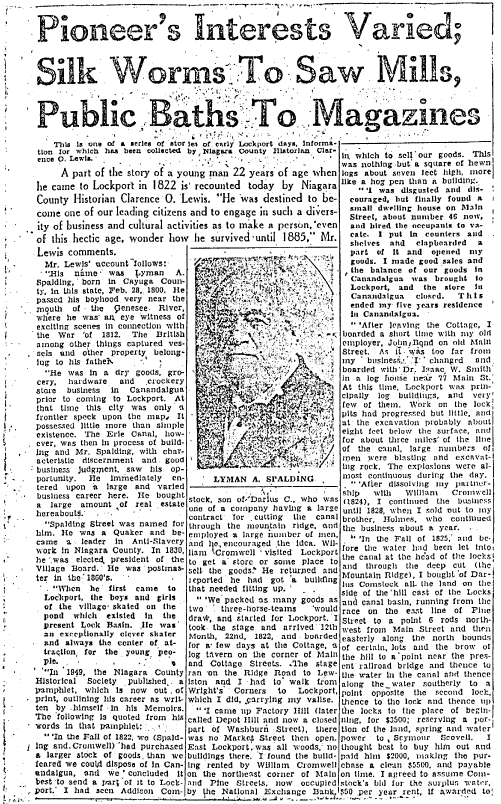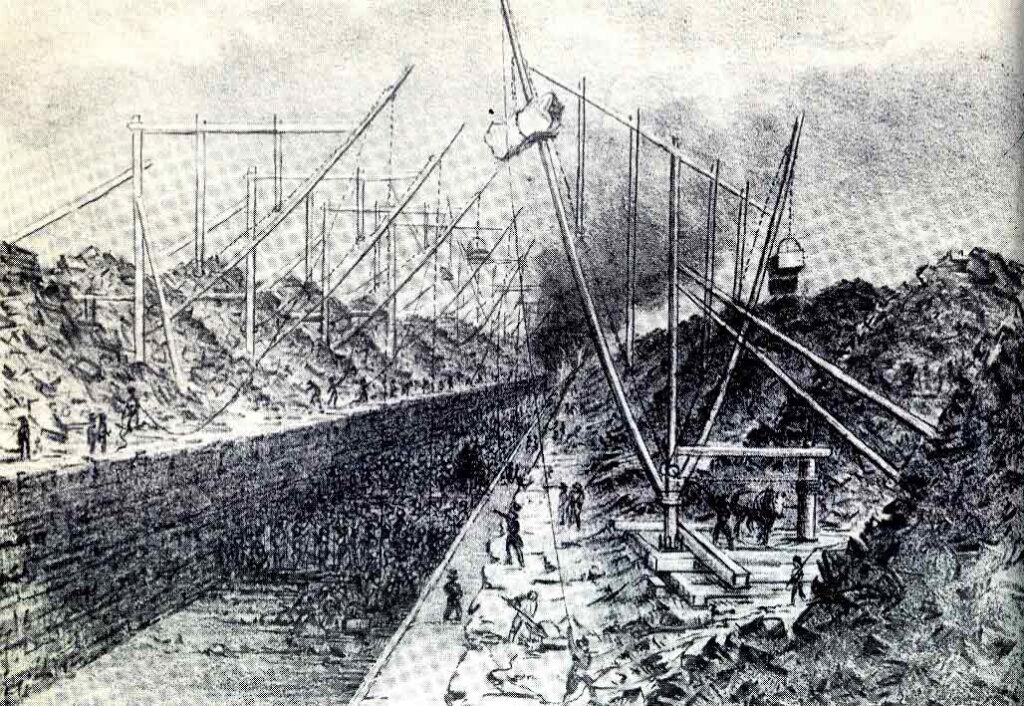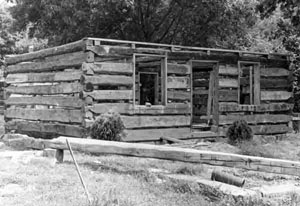This year, 2022, Spalding Hardware celebrates its 200th anniversary. The company was founded in Lockport, NY, in 1822 by Lyman A. Spalding and his business partner. This blog post is the first in a series showcasing the history of the Spalding Hardware company.
The following article appeared in the newspaper and was discovered in the historical archives at the Lockport Public Library. Read on below the image for the text of the article.

Pioneer’s Interests Varied; Silk Worms To Saw Mills, Public Baths To Magazines
This is one of a series of stories of early Lockport days, information for which has been collected by Niagara County Historian Clarence O. Lewis.
A part of the story of a young man 22 years of age when he came to Lockport in 1822 is recounted today by Niagara County Historian Clarence O. Lewis. “He was destined to become one of our leading citizens and to engage in such a diversity of business and cultural activities as to make a person, even in this hectic age, wonder how he survived until 1885,” Mr. Lewis comments. Mr. Lewis’ account follows:
“His name was Lyman A. Spalding, born in Cayuga County, in this state, Feb. 28, 1800. He passed his boyhood very near the mouth of the Genesee River where he was an eyewitness of exciting scenes in connection with the War of 1812. The British among other things captured vessels and other property belonging to his father.
“He was in a dry goods, grocery, hardware and crockery store business in Canandaigua prior to coming to Lockport. At that time this city was only a frontier speck on the map. It possessed little more than simple existence. The Erie Canal, however, was then in process of building and Mr. Spalding, with characteristic discernment and good business judgement, saw his opportunity. He immediately entered upon a large and varied business career here. He bought a large amount of real estate hereabouts.

“Spalding Street was named for him. He was a Quaker and became a leader in Anti-Slavery work in Niagara County. In 1830, he was elected president of the Village Board. He was postmaster in the 1860’s.
“When he first came to Lockport, the boys and girls of the village skated on the pond which existed in the present Lock Basin. He was an exceptionally clever skater and always the center of attraction for the young people.
“In 1949, the Niagara County Historical Society published a pamphlet, which is now out of print, outlining his career as written by himself in his Memoirs. The following is quoted from his words in that pamphlet:
” ‘In the Fall of 1822, we (Spalding and Cromwell) had purchased a larger stock of goods than we feared we could dispose of in Canandaigua, and we concluded it best to send a part of it to Lockport. I had seen Addison Comstock, son of Darius C., who was one of a company having a large contract for cutting the canal through the mountain ridge, and employed a large number of men, and he encouraged the idea. William Cromwell visited Lockport to get a store or some place to sell the goods. He returned and reported he had got a building that needed fitting up.
” ‘We packed as many goods as two three-horse-teams would draw, and started for Lockport. I took the stage and arrived 12th Month, 22nd, 1822, and boarded for a few days at the Cottage, a log tavern on the corner of Main and Cottage Streets. The stage ran on the Ridge Road to Lewiston and I had to walk from Wright’s Corners to Lockport, which I did, carrying my valise.
” ‘I came up Factory Hill (later called Depot Hill and now a closed part of Washburn Street), there was no Market Street then open. East Lockport was all woods, no buildings there. I found the building rented by William Cromwell on the northeast corner of Main and Pine Streets, now occupied by the National Exchange Bank, in which to sell our goods. This was nothing but a square of hewn logs about seven feet high, more like a hog pen than a building.

” ‘I was disgusted and discouraged, but finally found a small dwelling house on Main Street, about number 46 now, and hired the occupants to vacate. I put in counters and shelves and clapboarded a part of it and opened my goods. I made good sales and the balance of our goods in Canandaigua was brought to Lockport, and the store in Canandaigua closed. This ended my five years residence in Canandaigua.
” ‘After leaving the Cottage, I boarded a short time with my employer, John Bond on old Main Street. As it was too far from my business, I changed and boarded with Dr. Isaac W. Smith in a log house near 77 Main St. At this time, Lockport was principally log buildings, and very few of them. Work on the lock pits had progressed but little, and at the excavation probably about eight feet below the surface, and for about three miles of the line of the canal, large numbers of men were blasting and excavating rock. The explosions were almost continuous during the day.

” ‘After dissolving my partnership with William Cromwell (1824), I continued the business until 1828, when I sold out to my brother Holmes, who continued the business about a year.
” ‘In the Fall of 1825, and before the water had been let into the canal at the head of the locks and through the deep cut (the Mountain Ridge), I bought of Darius Comstock all the land on the side of the hill east of the Locks and canal basin, running from the race on the east line of Pine Street to a point 6 rods northwest from Main Street and then easterly along the north bounds of certain lots and the brow of the hill to a point near the present railroad bridge and thence to the water in the canal and thence along the water southerly to a point opposite the second lock, thence to the lock and thence up the locks to the place of beginning, for $3500; reserving a portion of the land, spring and water power to Seymour Scovell, I thought best to buy him out and paid him $2000, making the purchase a clean $5500, and payable on time. I agreed to assume Comstock’s bid for the surplus water, $50 per year rent, if awarded to […]’ “
